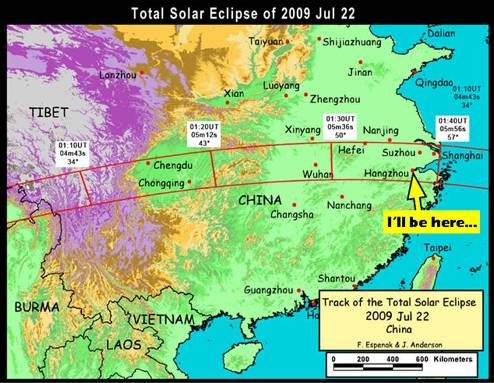Total Solar Eclipse – 22 July 2009
It’s time for another total solar eclipse!
And this time it’s going to be different… very very different… not because it’s the Eclipse of the Century, but because I’m going to China to witness it!!!
The path of the Moon’s umbral shadow begins in India and crosses through Nepal, Bangladesh, Bhutan, Myanmar and China. After leaving mainland Asia, the path crosses Japan’s Ryukyu Islands and curves southeast through the Pacific Ocean where the maximum duration of totality reaches 6 min 39 s.
6 minutes and 39 seconds!
That’s the longest total solar eclipse we can have for the 21th century! (and hence the Eclipse of the Century at the beginning of the post). We have to wait until Year 2132 to have a longer TSE than this one.
The reason for this long eclipse is simply because now is July; a time when the Sun is farthest away from Earth (aphelion), thus is smallest in size. And the Moon also just passes it nearest point to Earth (perigee), thus it looks big in our sky. Combine a small Sun with a big Moon, and bang, you have a long totality (the Moon will have more time to block the Sun).
As seen from the diagram above, Malaysia was not in the totality path (where the Moon’s umbral shadow is), but we are in the broader region of the Moon’s penumbral shadow – meaning that we can still see a partial eclipse. Even so, it’s not so favourable to us because at maximum the Moon only covers 8% of the Sun’s disk in Kuala Lumpur and 12% in Ipoh (and slightly more if you are further north). Click here for more details and here for animation.
In Kuala Lumpur,
First Contact – 8:29 am (when the Moon first “touches” the Sun’s limb)
Maximum Eclipse – 9:07 am (when the Moon covers the Sun’s disk the most; 8%)
Last Contact – 9:48 am (when the Moon “leaves” the Sun)
So you know a partial solar eclipse is going to be visible soon and you are looking forward to that. Now, how do you observe this event SAFELY?
There are few ways. You can project the image of the Sun onto a piece of paper or a wall either by using pinhole projector (long box or cardboard) or telescope, or use a solar filter either the glasses type or attached it in front of a telescope. Only then, you can observe the Sun safely. You don’t really need a telescope to enjoy this.
Caution: Sunglasses, exposed film, x-ray film, polaroid filters etc. are NOT suitable to be used for Sun observation. Use only filters or glasses that are specially made for Sun viewing.
Remember this: Safety precautions always have to be taken for any observations involving the Sun. NEVER EVER look at the Sun directly without any safety filters. The consequences will be a damaged eye or blindness.
Please bear in mind that although the Sun will be partially covered, the remaining of the crescent Sun will still be intense enough to damage your eyes. It is NOT safe at all to look at the partial Sun directly.
I’ll be in Hangzhou observing. The duration of totality is about 5 minutes; hope I’ll stay calm, not panic, and have enough time to take some decent photographs to share with you all.

Wish me clear skies in China!!!
~~~~~
More information:
NASA Eclipse Website
Mr. Eclipse (Fred Espenak)
Total Solar Eclipse of 2009 Jul 22.pdf – a very complete information on this solar eclipse




All the best and enjoy your solar elipse trip!
Thanks! Hope everything will go on smoothly…
[…] trip was excellent! I managed to see the eclipse, which is BREATH-TAKING!!! and also manage to snap some photos (although I’m not very happy with […]
Some updates on my China Eclipse Trip… « My Dark Sky said this on July 30, 2009 at 6:16 pm |
[…] reached Hangzhou on 20 July, two days before the big day. It was hot! The temperature was 38 degC. Imagine yourself standing in front of an air-con […]
My China Total Solar Eclipse Trip – Part 1 « My Dark Sky said this on August 2, 2009 at 12:55 pm |
[…] Total Solar Eclipse – 22 July 2009 […]
中国日全食和寻星天文学会举办的日偏食观赏会 Total Solar Eclipse in China & Starfinder Astronomical Society Partial Solar Eclipse Observation (22/07/09) said this on October 6, 2009 at 3:50 pm |